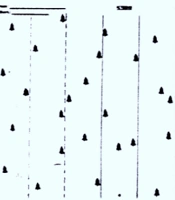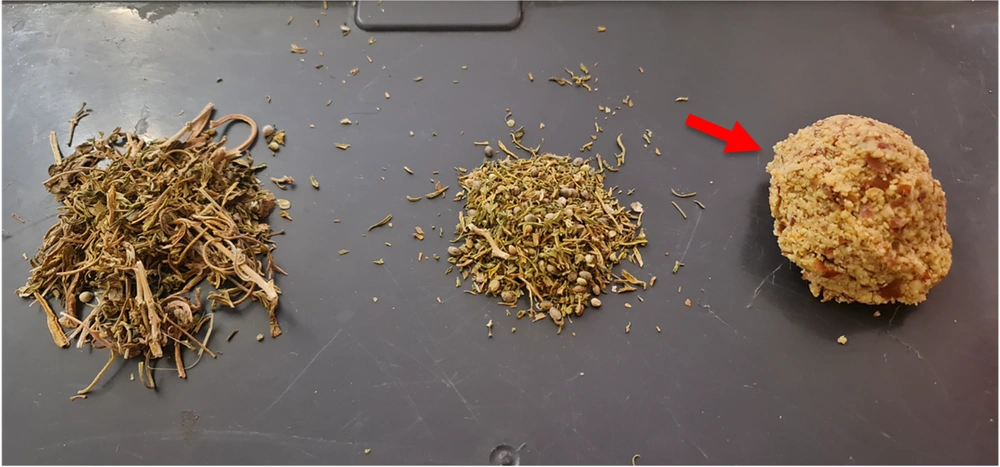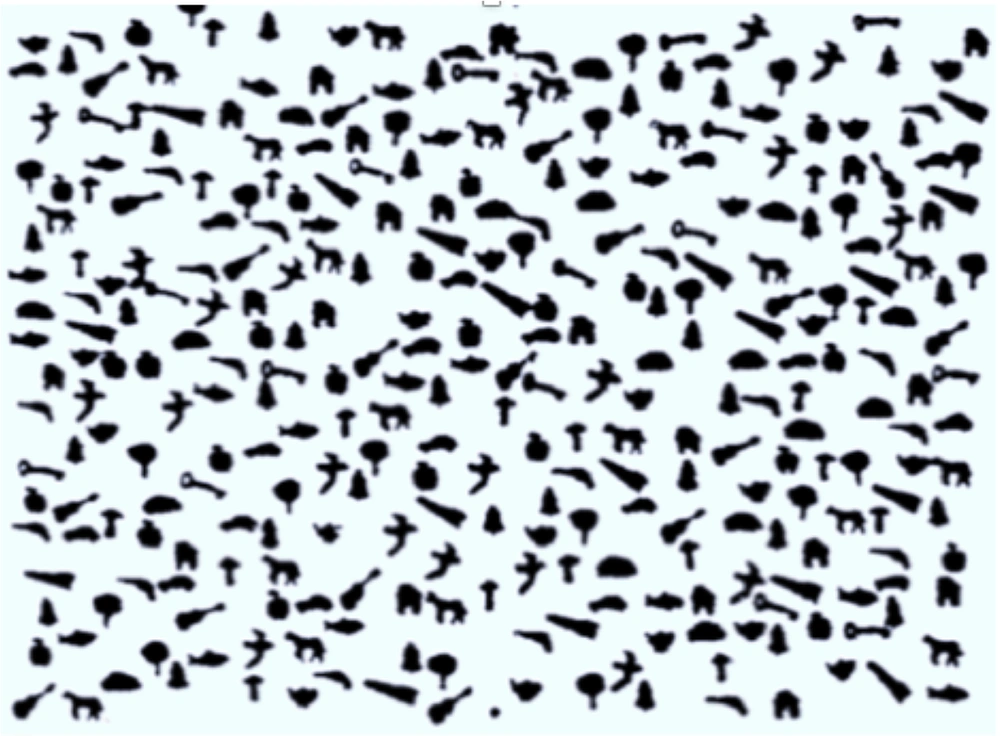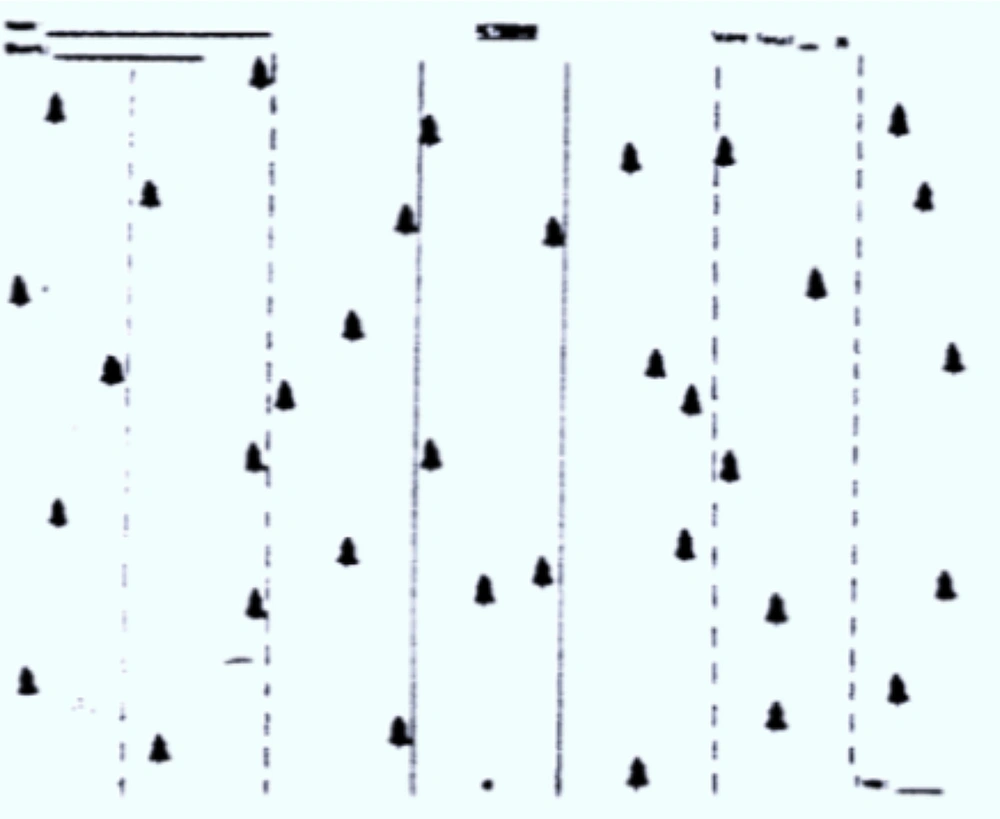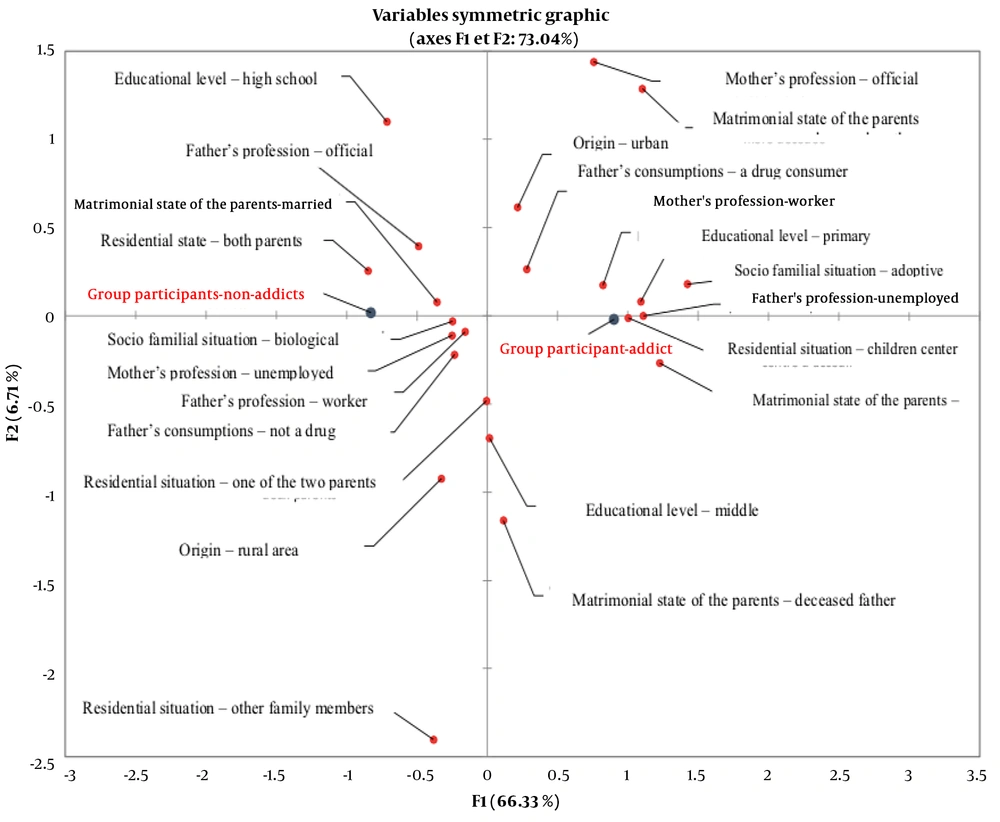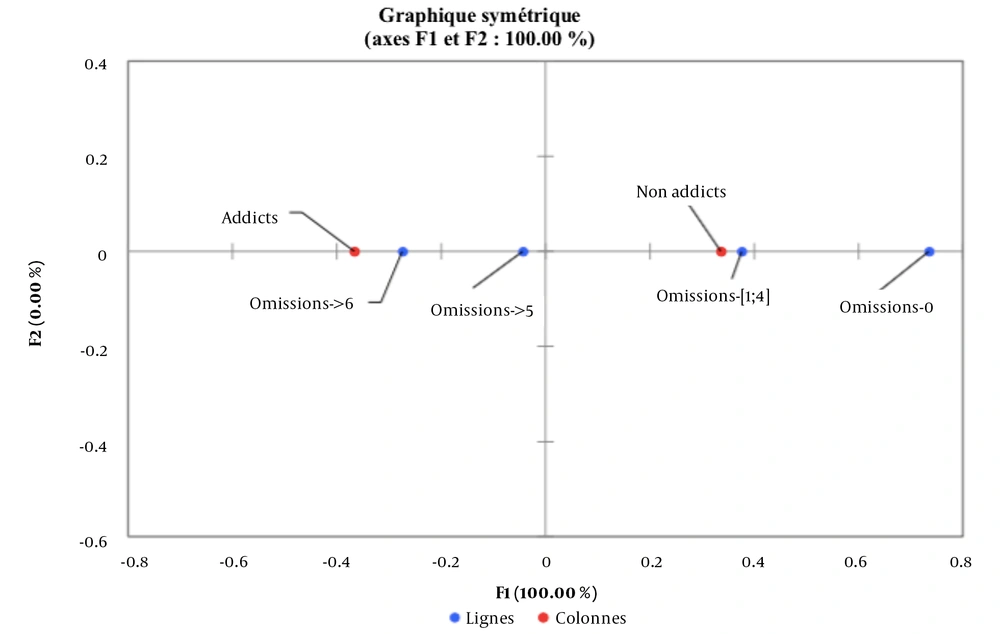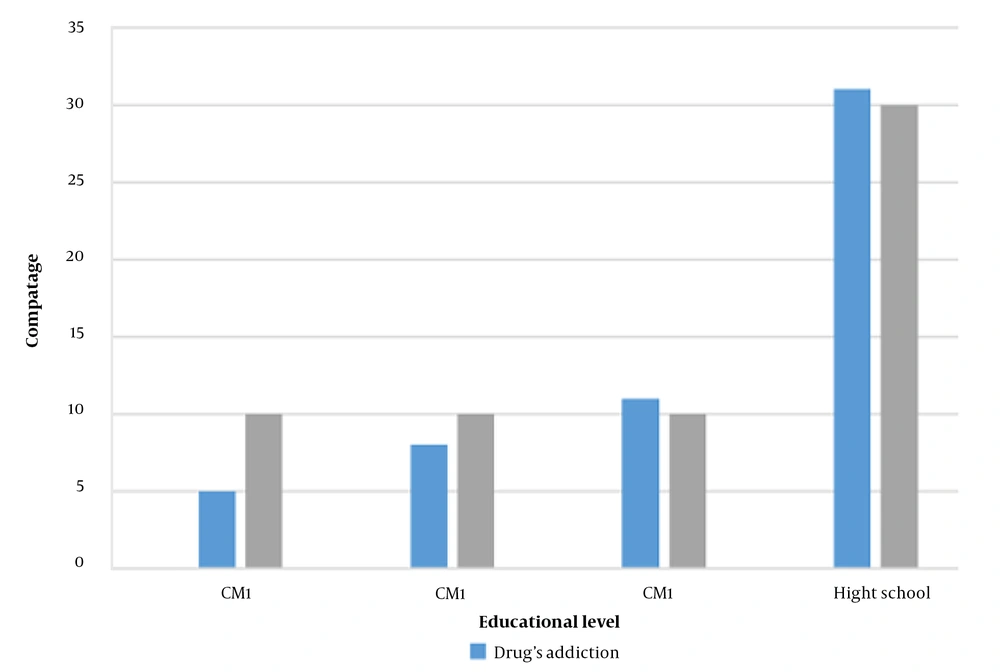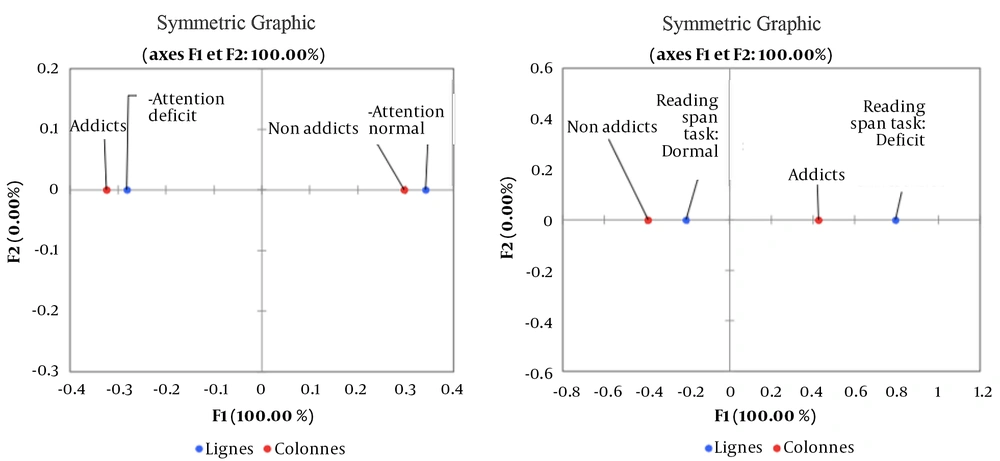1. Background
In Morocco, cannabis consumption is illegal; however, it is already widely cultivated and consumed in different traditional forms. Among the traditional drugs containing cannabis, Mâajoune is very common. This drug incorporates cannabis as the principal ingredient, and different substances along with atropine, hallucinogenic plants, poppy seeds, and psychotropic tablets; noticeably, this composition changed into the maximum incriminated substance of drug poisoning instances pronounced of the Poison Control and Pharmacovigilance Centre of Morocco (1). Mâajoune is an illicit substance consumed in Morocco. It is a dough crafted from hashish resin and vegetable spices, known for its aphrodisiac effects (1, 2).
This drug, as well as many others, can have negative consequences for drug users, affecting their physical and mental health (3). It can also affect judgment, decrease intellectual functioning, and even lead to memory loss (4). Mâajoune was the most widely abused drug, resulting in consumer poisoning (49.9% of all substance abuse intoxications). For young populations, specifically adolescents, the risks are high (1). The average age of Mâajoune users was 19.6 ± 8.4 years; nevertheless, the most affected age group was adults (45.6%) followed by adolescents (32.6%) and then users aged less than 15 years (i.e., infants, toddlers, and children 22.1%). In addition, the sex ratio (M/F) of Mâajoune consumption was 3.6. Clinically, the risk factor for hospitalization due to this drug use was high for users under 15 years (P < 0.01, OR = 1.6) [1], and addictive circumstances were the most frequent (66.4%), followed by accidents (30.4%). In 85.6% of cases, hospitalized patients were symptomatic. However, the predominant clinical signs were gastrointestinal for 40.3% and neurological for 38.4% (1, 5).
Youth, who are the most affected population by this drug’s misdeeds, can show cognitive distortions explaining impulsive tendencies, intolerance to frustration, and the inability to contain feelings. From a psychological and neurological point of view, drug addiction is a direct cause of cognitive disorders. Additionally, the brain regions and processes involved in addiction largely overlap with those involved in critical cognitive functions. These functions include learning, memory, attention, reasoning, and impulse control. Drugs alter the brain’s normal structure and function in these areas, leading to neurological changes. These modifications in the brain can lead to neurobehavioral adaptation favoring chronic addiction with difficulty weaning (6). On the other hand, visual attention refers to the cognitive process that mediates the selection of relevant information and the filtering out of data from visual scenes (7).
Using Mâajoune poses a worrying health problem. It is a real scourge that is spreading at an alarming rate. At a young age, especially in the school environment, we are witnessing a growing addiction to these substances. The neurological and neurocognitive effects of these drugs have been widely debated. However, Maajoune contains several known highly toxic components, such as cannabis and Papaver somniferum L. Pavot. In the literature, no accurate data on the cognitive effects of Mâajoune have been found.
2. Objectives
The present study aimed to investigate the neurocognitive effects (i.e., visual intention, visuospatial neglect, and memory) in relation to the use of Mâajoune for adolescents and to compare them with a control group.
3. Methods
3.1. Drug Characteristics
Mâajoune (Figure 1), also known as «Haschich Balls» during the 21st century and «Katila» or even known as “kika”, is an ancient traditional confectionery that dates back many centuries, consumed during festivities in certain regions of Morocco, particularly in the Northern regions (2). Mâajoune is a dough prepared containing hemp resin and a mixture of plants and spices known for their aphrodisiac effects. It is often eaten with cakes, sweets, dishes, or as an accompaniment to hot drinks. Mâajoune can be consumed for well-being or an aphrodisiac effect. Furthermore, it can be used for addictive purposes given the accessibility of these components, their low cost, and their ease of preparation. The composition of this mixture differs by region; however, Indian hemp is almost constant.
In Morocco, the main component of Mâajoune is Indian hemp (kif) (Cannabis sativa L.), which belongs to the Cannabaceae family. Its Arabic names are Qunnab, Charnaq, Kif, Hachich, or Chira (Indian hemp resin). The active ingredient is tetrahydrocannabinol (THC) and its derivatives. Indian hemp is traditional. It is a sedative, narcotic, and antispasmodic, used in three forms: marijuana, hashish, and hashish oil. They can be differentiated according to their THC content and secondly by their method of preparation from female plants.
Mâajoune is prepared from hashish (cannabis resin) with a high THC content of 5-40%, and to complete the preparation, consumers add oil with a very high THC content (> 50%). This oil is obtained from the hot maceration of the plant’s resinous parts in vegetable oil. Afterward, consumers add other products whose toxicity varies; there are several varieties depending on the components and the method of preparation. For example, the «kartassa», which means «Bullet», is a variant of Mâajoune that contains cannabis with spices, such as (Papaver somniferum ssp. somniferum) from the family of Papaveraceae or other families, such as Papaver rhoeas or Chelidonium majus (2, 8).
3.2. Participants and Data Collection
This randomized case-control analytical study was conducted in 3 addiction centers and the Child Protection Center of the central region. Afterward, the control cases were recruited from four schools situated in the same region. Young individuals aged between 10 and 18 years who used Maajoune exclusively were included in the present study. Adolescents who have been diagnosed with neurological diseases causing cognitive disorders (e.g., epilepsy, stroke, and mental confusion), psychiatric diseases (e.g., depression, bipolar disorder, schizophrenia, obsessive-compulsive disorder, Threshold Assessment Grid, and panic disorder), or vision dysfunctions (e.g., myopia, hyperopia, and strabismus) were excluded from this study. During the data collection, the privacy and confidentiality of the participants were respected. The consent of the participants’ tutors was required after having explained the progress of the study and the different tests used. Therefore, the right to self-determination was also considered.
3.3. Neurocognitive Tests
This battery was designed to evaluate areas of cognitive activity suspected of alcohol and other drugs based on research on adults and adolescents (4, 9-11), identifying six common areas of addiction-related deficits: (1) general intelligence; (2) language; (3) visuospatial; (4) attention; (5) memory; and (6) problem-solving skills. The visual attention function analysis was assessed through the Bells Test, which is both a quantitative and qualitative test for attention deficit neglect. The Bells Test (Figures 2) and 3) is a cancellation task widely used for unilateral spatial neglect (USN). It is widely used for USN diagnosis (12, 13); the patient must cross out bells scattered among several different shapes on a sheet of paper. The test is generally easy to administer and score; it allows quick visualization of the jump locations and the visuospatial model of the scan. Therefore, it provides a sensitive estimate of the USN when the difference is calculated between the number of strikethrough targets on the right side and the number of strikethrough targets on the left side (skewness score). This index provides information on the selective omission of target stimuli in the contralesional hemispace, a well-known indication of USN. It was also observed that the omission of target stimuli across the entire sheet and the operating time were effective in assessing attentional processing separately from asymmetric exploration (12).
In addition, ignoring target stimuli from the entire sheet and execution time assesses the attentional component independent of asymmetric studies (6, 7, 12, 14). The Bells Test was performed on the same general principle as Albert’s Test. It consists of seven columns, each of which contains a certain number of goals. First, the examined subjects are presented with a sheet of 21.5 × 28 cm with different contours of objects (e.g., house, horse, and bell). Then, a total of 35 targets (bells) are distributed equally in seven columns. Each column had the same number of targets (n = 5) and distractors (n = 40), and all pictures were black, similar to Chinese shadows. Out of seven columns, three were on the left side of the page, one was in the middle, and three were on the right side. Therefore, if the subject puts the circle bells in the last column on the left, it can be considered that his/her visual neglect is mild. It can also be suggested as greater neglect of the left side of the space. The present study’s results are presented according to predefined calibration as ODEDYS (2005 version 2), which is a rapid screening test for children with dyslexia. In this version, a calibration from the primary school levels to the high school levels was added.
3.4. Statistical Analysis
The statistical analysis was performed using SPSS software (version 20). The descriptive analysis consisted of the calculation of absolute and relative frequencies for qualitative variables. Then, positioning and dispersion parameters for quantitative variables were generated using standard statistical parameters (i.e., mean and standard deviation). For this purpose, the current study used a multivariate statistical method, namely correspondence factor analysis (CFA) and the chi-square test. The comparison of the qualitative variables was carried out by Fisher’s exact test. The Student’s test and the one-way analysis of variance (ANOVA) were used to compare the obtained averages. The results were considered statistically significant when P < 0.05.
4. Results
4.1. Epidemiologic, Social, and Environmental Factors and Characteristics of Maajoune Users
The results were obtained from a population of 115 adolescents (N = 115). From an analysis of the multiple correspondences of the variables, 2 groups could be distinguished from the social and environmental causes that drove them to their drug addiction: drug addicts who reside in a children’s center, from an urban region, with divorced parents, unemployed father, socio-familial adoptive situation, primary scholar level, a worker mother, and a drug consumer father, and non-addict residents with one or both parents, from an urban region, with married parents. The father’s profession is either an official or a worker, with a biological socio-familial situation. Their mother is unemployed, and their father is not a drug consumer (Figure 4).
The mean age of the studied population was 16 years (range: 10 - 18 years), with a sex ratio of 0.83. The mean age of the onset of drug use was 12 years (range: 7 - 17 years), the mean duration of use was 3 years (range: 1 - 8 years), and the median was 2.75 years. The frequency of use was daily in 54 subjects. Attempts to quit were reported by 42 participants, 8 attempts of which were followed by a healthcare professional (Table 1).
| Variables | Gender | Chi-square Test | Significance (P-Value) | |
|---|---|---|---|---|
| Male; No. | Female; No. | |||
| Age (y) | 10.711 | 0.152 | ||
| 10 | 1 | 0 | ||
| 12 | 0 | 1 | ||
| 13 | 0 | 2 | ||
| 14 | 2 | 3 | ||
| 15 | 4 | 4 | ||
| 16 | 6 | 7 | ||
| 17 | 7 | 13 | ||
| 18 | 5 | 0 | ||
| Age of onset of Maajoune use (y) | 7.452 | 0.682 | ||
| 7 | 1 | 0 | ||
| 8 | 0 | 1 | ||
| 9 | 1 | 1 | ||
| 10 | 3 | 2 | ||
| 11 | 5 | 2 | ||
| 12 | 3 | 3 | ||
| 13 | 5 | 8 | ||
| 14 | 3 | 6 | ||
| 15 | 2 | 4 | ||
| 16 | 1 | 3 | ||
| 17 | 1 | 0 | ||
| Maajoune use duration (y) | 8.702 | 0.275 | ||
| 1 | 4 | 9 | ||
| 2 | 3 | 4 | ||
| 3 | 6 | 8 | ||
| 4 | 4 | 6 | ||
| 5 | 1 | 2 | ||
| 6 | 4 | 0 | ||
| 7 | 1 | 1 | ||
| 8 | 2 | 0 | ||
| Maajoune use frequency | 1.222 | 0.269 | ||
| Irregular | 1 | 0 | ||
| Daily | 24 | 30 | ||
| Maajoune withdrawal attempt | 14.187 | 0.0002‡ | ||
| Yes | 25 | 17 | ||
| No | 0 | 13 | ||
| Medically supervised withdrawal | 11.234 | 0.001‡ | ||
| Yes | 8 | 0 | ||
| No | 17 | 30 | ||
Characteristics of Maajoune Users a
4.2. Impact of Visual Intention
The factorial analysis of the correspondences of the two dependent variables (P = 0.003) showed that the omissions higher than 6, followed by omission 5, were linked mainly to drug addictions. On the other hand, omissions (1 - 4) followed by omissions 0 were related to non-addicts to drugs. The average scores of the studied sample on the Bells Test of the addict’s group (G1) and control group (G2) were 23.27 ± 7.51 and 28 ± 5.01, respectively. The median scores were 26 and 30.5 points for group (G1) and group (G2), respectively. On the other hand, there was no omission for 2% and 13% in G1 and G2 (P > 0.05), the omission of 1 to 4 items for 16% and 37% in G1 and G2 (P < 0.05), the omission of 5 items for 9% and 8% in G1 and G2 (P < 0.05), and the omission of 6 items for 73% and 42% in G1 and G2 (P < 0.05) (Figure 5), respectively.
4.3. Analysis of Visuospatial Neglect
Four types of dominant visual neglect were registered (Table 2). Bilateral visuospatial neglect (BVN) was registered in 36% and 17% of adolescents of G1 and G2 (P < 0.05), right visuospatial neglect in 24% and 13% of G1 and G2 (P < 0.05), left visuospatial neglect in 5% and 10% of G1 and G2, and central visuospatial neglect in 4% and 2% of G1 and G2 (P > 0.05).
| Variables | Drug Addiction | Chi-square Test | Significance (P-Value) | |
|---|---|---|---|---|
| Addicts; No. | Non-addicts; No. | |||
| Omissions | 14.167 | 0.003‡ | ||
| 0 | 1 | 8 | ||
| (1-4) | 9 | 22 | ||
| 5 | 5 | 5 | ||
| > 6 | 40 | 25 | ||
| Visuospatial hemineglect | 3.316 | 0.345 | ||
| Center | 2 | 1 | ||
| Right | 13 | 8 | ||
| Right and left | 20 | 10 | ||
| Left | 3 | 6 | ||
| No response | 17 | 35 | ||
Analysis of Different Components of Executive Functioning (EF) in Maajoune Users a
4.4. Analysis of Memory
Using the average scores from the reference (ODEDYS-2, 2005), the Reading Span Task showed that short-term verbal memory was more affected in 11% of high school addict subjects and 5% for the CM2, 4% of the CM3, and 1% of the CM1. Additionally, the Reading Span Task revealed that the capacities of short-term verbal memory were altered for 24% of the high school addict subjects and 10% of the CM3, 8% of the CM2, and 2% of the CM1 (Figure 6).
The addicted group score was significant regarding attention disorder (P = 0.001‡) and memory troubles (P < 0.000001‡) (Table 3). In addition, the CFA of the two variables (P = 0.001‡) showed that the attention deficit was linked mainly to drug addiction, and no addiction was linked to normal attention (Figure 7).
| Variables | Addiction | Chi-square Test | Significance (P-Value) | |
|---|---|---|---|---|
| Addicts; No. | Non-addicts; No. | |||
| Education level | 1.739 | 0.628 | ||
| CM1 | 5 | 10 | ||
| CM2 | 8 | 10 | ||
| CM3 | 11 | 10 | ||
| High school | 31 | 30 | ||
| Attention | 11.067 | 0.001 ‡ | ||
| Normal | 16 | 36 | ||
| Disorder | 39 | 24 | ||
| Upright numbers memory | 19.132 | 0.00001 ‡ | ||
| Normal | 34 | 57 | ||
| Disorder | 21 | 3 | ||
| Upside-down numbers memory | 51.486 | < 0.000001 ‡ | ||
| Normal | 11 | 52 | ||
| Disorder | 44 | 8 | ||
5. Discussion
The analysis of the results showed that the familial situation and matrimonial status of the parents of G1 were highly associated with divorce and adoption, which affected the adolescent’s living environment (15). The average age of the first drug use ranged between 10 and 15 years for 34 adolescents. Mâajoune, which is used as a drug, is yet considered a new one since it has not been studied in the literature. The neurological effect and induced alteration were not recognized (5, 16). The duration of drug use was mainly less than 4 years.
The Bells Test designed by Gauthier et al. (12, 16) for the visual attention evaluation allowed the researchers to confirm that attention was considerably affected in the addicted group (23.27 ± 7.51). Moreover, the study of the significant omission (> 6 bells) on the right or on the left showed that 73% of drug-addicted cases presented bilateral negligence (right and left side), and 36% of them showed a unilateral neglect profile, particularly in the right side with 24% of the cases.
It has been reported that cannabis, ecstasy, amphetamines, and cocaine can impair cognitive functioning. In similar studies, the most common negative effects of illicit drug use were health-related mental disorders, including mood disorders (dysphoria), anxiety, panic attacks, sleep disturbances, and memory loss (17).
Neglect often occurs after damage to the right hemisphere of the brain caused by a stroke in the middle cerebral artery. Although this abnormality is often associated with parietal lesions, most middle cerebral artery strokes affect multiple regions. Many patients present with various combinations of parietal, temporal, and frontal lesions (18).
In addition, neglect might follow a subcortical stroke, although this might be related to hypoperfusion and dysfunction of the upper cortical areas (19). It is believed that these abnormalities are caused by the endogenous cannabinoid system. This regulates a variety of physiological functions via specific cannabinoid receptors (CBs) expressed in the brain and peripheral tissues. Cannabinoid CB1 receptors mediate various neurological processes; nevertheless, CB2 receptors regulate immune responses and are involved in drug addiction and neuroinflammation (20).
Several studies suggest that impairments or abnormalities in different types of tasks are likely localized to some regions. Moreover, neglect results from damage to the neuronal networks of some regions involved in attention (20). Recent studies have shown that it can also result from damage to white matter tracts, particularly the superior longitudinal fasciculus, particularly in the cortical and subcortical regions. Acute intoxication might lead to persistent impairments in emotional and cognitive processing due to irreversible brain damage (13, 20). The right frontal and parietal regions involved in spatial functions, including attention deployment, are also involved in several non-spatial processes, such as the ability to maintain performance on a task over an extended period of time. Therefore, these non-spatial impairments are often associated with or potentially exacerbated by neglect’s spatial features. The right hemispheric lateralization of these cognitive domains also explains the increased severity of left neglect compared to the right (6, 19).
In addition, the present study’s results showed an association of attention deficit with a visuospatial disorder from the scan study of the Bells Test. The present study also diagnosed a right semi-neglect in the group of drug addicts, probably due to a left hemisphere lesion. Spatial negligence (SN) has been defined as a singular difficulty in detecting, responding to, or directing one’s attention toward stimuli presented on the contralateral side of a brain injury, especially in the right hemisphere. This syndrome increases the severity of motor and sensory deficits and predicts poor functional prognosis (12).
Mild residual impairing effects were also observed in these exact same cognitive domains, suggesting that adverse effects following cannabis intoxication persist for at least days or weeks following cannabis abstinence (12). El Azmy et al. (11) demonstrated in their study, carried out on children aged from 11 to 18 years in the M’rirt area in Middle Atlas, Morocco, that 32% of subjects had attention problems and 4.41% had a profile of right USN. El Azmy et al. (11) associated this attention deficit with learning problems, which could hinder the academic success of these children. This finding is confirmed by several studies that reported the existence of a link between visual processing and academic success (21, 22).
The drugs consumed by the young participants in the current study will probably affect cognitive functions and engender visual attention deficits, such as visuospatial hemineglect. The results of another study showed that several drugs (e.g., cannabis, nicotine, and ecstasy) disturb the functioning and the different brain regions involved in the attention process, the attentional guidance system and the brain areas associated with this system, the posterior parietal cortex, the lateral nucleus of the thalamus and superior colliculus, and the anterior attention system and the cerebral structures associated with the dorsolateral prefrontal cortex, orbitofrontal, anterior cingulate cortex (22, 23).
To the best of our knowledge, this is the first study that is interested in the neurocognitive effect of the Mâajoune drug in young individuals. It is possible to think about the need to care for these young individuals with neurocognitive deficits due to this drug addiction. Over the years, a large number of studies and many different techniques have been proposed to treat neglect symptoms. Among these proposed rehabilitation methods are eye-patching, caloric vestibular stimulation, visuomotor imagery, mirror therapy, transcutaneous electrical nerve stimulation (TENS), optokinetic stimulation, and constraint-induced movement therapy (1, 24).
5.1. Conclusions
The results obtained in this study confirm the effect of the Mâajoune drug use on visual attention, executive functions, and memory disorders. The evaluation of the effects of drug addiction, commonly used by young individuals, on cognitive functions indicated a set of cognitive disorders detected in adolescents addicted to different drugs, such as cannabis, synthetic glue, and cocaine. Chronic dependence on these drugs (e.g., cannabis, ecstasy, and heroin) leads to cognitive disorders, which result in a decrease in memory capacities, a decrease in attentional performance, and a disruption of organizational strategy. It is imperative that drug addiction treatment centers and socio-educational institutions rethink strategies for caring for this population through the development of a more comprehensive care plan for drug addicts based on a holistic and global approach. In addition to assessing physical health, neurocognitive and behavioral disorders associated with drug use also need to be evaluated and corrected. Consequently, it will have a direct impact on their academic progress and future prospects.
